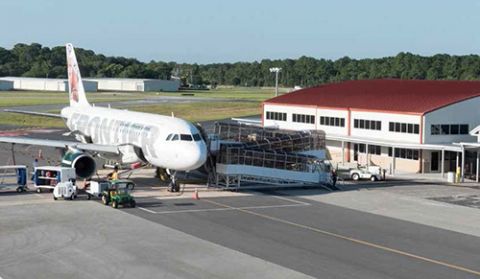Northeast Florida Regional Demolishes Old Terminal & Erects New in 100 Days

While U.S. presidents like to talk about plans for their first 100 days in office, officials at Northeast Florida Regional Airport (SGJ) can proudly show what they accomplished in 100 days. SGJ closed its existing terminal, tore that structure down and constructed a new 14,000-square-foot facility-all while maintaining flights into and out of the airport.
 SGJ officials knew they were going to have to do something about their terminal, an insulated and air-conditioned tension fabric structure constructed in 2007 when the airport began commercial air service. The 9,000-square-foot facility served its purpose but took a basic approach to handling travelers, informs Ed Wuellner, AAE, executive director of St. Augustine-St. Johns County Airport Authority.
SGJ officials knew they were going to have to do something about their terminal, an insulated and air-conditioned tension fabric structure constructed in 2007 when the airport began commercial air service. The 9,000-square-foot facility served its purpose but took a basic approach to handling travelers, informs Ed Wuellner, AAE, executive director of St. Augustine-St. Johns County Airport Authority.
Moreover, the Florida sunshine is hard on fabric structures. Replacing the exterior skin of SGJ's previous terminal would have cost nearly $1 million, and other structural components also needed work, explains Wuellner. Another important consideration: The airport would have had to fully finance the rehabilitation work itself.
| FACTS&FIGURES Project: Demolish Existing Terminal & Construct New One on Same Footprint Location: Northeast Florida Regional Airport (St. Augustine) Cost: $4.1 million Funding: Airport (50%), FL Dept. of Transportation (50%) Timeline: Design work began June 2015; demolition ensued Jan. 2016; first flight at new terminal April 2016 Program Management, Architectural Design & Engineering: Passero Associates General Contractor: Elkins Construction Construction Project Management: CBRE Electrical Systems: Ohmega Group Video & Flight Info Display Integration: Synect Structural Systems: Structures Int'l Passenger Ramps: Aviramp Exterior Canopies: Peachtree Awnings Security & Access Control: Johnson Controls Of Note: Demolition & new construction completed in 100 days; tilt-wall construction allowed construction of new facility to begin before old terminal was demolished |
By committing airport funds to constructing a new facility, however, SGJ was able to split the cost equally with the Florida Department of Transportation. The result is a "real brick-and-mortar type building" as Wuellner describes it, and the airport only had to pay for half of the $4.1 million project.
When Opportunity Knocks
In June 2015, Frontier Airlines, one of SGJ's two commercial carriers, informed airport officials it would be suspending operations for a brief period in early 2016 while it rescheduled local service. Airport officials saw the airline-imposed hiatus as an opportunity to fast track their terminal plans.
Within approximately six months, the airport and its partners developed a design-build package to demolish the existing terminal and build a new one in 100 days. Closing the terminal on Jan. 4, 2016, they committed to opening SGJ's new terminal for business 110 days later on April 14, 2016.
Passero Associates served as the architectural and engineering firm for the project, with Elkins Construction as general contractor. "There was no way we were going to use a traditional design-bid-build approach and feel confident that the building would be done in time," says Andrew Holesko, vice president and director of aviation service for Passero. "Using traditional methods, it would have taken at least a year, maybe 18 months."
Design work began in June 2015. Given the general lifespan of fabric structures and cost estimates to rehabilitate SGJ's particular facility, airport officials determined that a new, more durable structure was in the best interest of the airport and community.
 Deciding what type of structure-metal, concrete block-and devising a plan to design and build it in such a short time frame were the real challenges. "It took a bunch of very creative professionals to figure out how to build it and get it done in time," recalls Holesko. "Our design-build team met sometimes on a daily basis to work on everything from foundations to roofing structure. Meetings included civil, structural, mechanical and electrical engineers, along with the architect and general contractor-everyone cross talking to make sure everyone knew and understood what others were working on."
Deciding what type of structure-metal, concrete block-and devising a plan to design and build it in such a short time frame were the real challenges. "It took a bunch of very creative professionals to figure out how to build it and get it done in time," recalls Holesko. "Our design-build team met sometimes on a daily basis to work on everything from foundations to roofing structure. Meetings included civil, structural, mechanical and electrical engineers, along with the architect and general contractor-everyone cross talking to make sure everyone knew and understood what others were working on."
Designs for the new terminal leveraged tilt-wall construction, which allowed contractors to begin work on the walls in late November and December, before the existing terminal was shut down. Crews poured a temporary 2-inch concrete base over a section of SGJ's asphalt apron to create a level surface where contractors could work without harming the airfield pavement. Workers used the area to fabricate wood forms; set rebar; create openings for windows, doors and reveals; and then pour the concrete walls. While the walls cured, preparations were underway to close the old terminal. Later, workers removed the concrete overlay and returned the asphalt apron to service.
Crews began demolishing the existing structure on Jan. 4, 2016, after the last plane for the day departed; 72 hours later, the old terminal was gone. Working off the old terminal's existing concrete pad, crews expanded the footprint by 5 feet on both the north and south ends, and 20 feet to the east and west. Workers also completed the new footers, which they had started before demolition, and used a large crane to lift the pre-constructed concrete walls into place.

The new brick and mortar terminal replaces a tension fabric structure constructed in 2007.
 Passero Senior Aviation Architect Christopher Nardone explains that tilt-wall construction was an ideal approach for the SGJ project because it not only allowed contractors to get a head start on the time-sensitive project, it also met building code requirements for high impacts. The building is designed and built to withstand 142 mile per hour winds.
Passero Senior Aviation Architect Christopher Nardone explains that tilt-wall construction was an ideal approach for the SGJ project because it not only allowed contractors to get a head start on the time-sensitive project, it also met building code requirements for high impacts. The building is designed and built to withstand 142 mile per hour winds.
Curved Roof Design
The tilt-wall construction exposes steel and curved beams in the building's interior, and the curved exterior roof is reminiscent of the World War II era. "Architecturally, it is reminiscent of the Quonset hut design," Wuellner notes.
In the main lobby, 30-foot ceilings lend an open, spacious feel as travelers enter through automatic doors. Ticket counters are located to the right, restrooms to the left, and TSA operations occupy the center of the building. The post-security area of the building, which accounts for more than half of the total square footage, includes seating for about 375 travelers. Most of the 25 common-use LED monitors scattered throughout the terminal display airline flight information. Some, however, display marketing and promotional messages from local businesses.
Four doors open onto the airfield for ground loading. Covered switchback units protect travelers from inclement weather while they board and deplane.
From a design and amenities standpoint, SGJ heeded the advice of its carriers and focused on function and simplicity-Home Deport vs. Macy's is how Wuellner describes it. "Our niche is leisure-type carriers," he explains. "Our travelers are not interested in frills."
To that end, the new terminal includes a somewhat unusual baggage claim area. When travelers disembark on the ramp, they walk directly to a 120-by-37-foot canopy structure set a few feet away from the terminal. Baggage is offloaded and carted directly into the outdoor structure, where passengers can claim their luggage and leave without entering the terminal.
"The baggage claim canopy has a Caribbean island feel," Holesko observes. "When travelers get off the airplane, they don't need to go into the building. They can be off the plane and in their car within 10 minutes."
The canopy roof of the baggage claim area follows the same curvature as the larger terminal building and is supported with corrosion-resistant clear anodized aluminum to guard against the brackish coastal air.

Tilt-wall construction allowed contractors to begin work on the concrete walls before the existing terminal was shut down.
Nardone notes that the terminal design plays to the departure experience more than arrivals. "While there are a few windows at eye level on the landside of the building, the interior of the building is all about seeing the airfield," he explains. "The building's larger airside windows open to the airfield. It's about experiencing the aircraft on the airfield. When travelers land, the experience is about getting off the plane and grabbing one's bags. Few people enter the building unless they need to use a restroom or rent a car."
Team Effort
The design-construction team, which included 25 various building trades, worked day and night shifts for 24,000 work hours to complete the project on time and allow Frontier Airlines to resume operations April 14. Work occurred adjacent to active taxiways with zero foreign object debris or safety incidents, report airport officials.
Via Air, SGJ's other commercial carrier, maintained its operations throughout the project in temporary trailers adjacent to the construction site. TSA shared space in the trailers for passenger screening. "On some days, we had 50 to 100 construction workers on what one would think would be a closed down site," Holesko reports. "But we accommodated Via Air's operations as well as TSA."

Heeding the advice of its carriers, SGJ focused on basic customer comfort and efficiency vs. extra amenities and frills.
Wuellner praises the cooperative effort: "It took a group of very talented people paying very close attention to the window of time available to get this done. Tearing down an existing structure and constructing a new building in such a short time frame would not have been an option for most contractors and engineers. We are extremely grateful to the project team."
"Nothing would have been more embarrassing than reading 'Plane Delayed' instead of 'Terminal Opens on Time,'" adds Nardone. "We were going to be either heroes or losers. But we had a great team of risk-takers who were focused and able to pull this off with no major hiccups or budget busters."
FREE Whitepaper
Fairbanks International Airport Baggage Transport Conveyor Enhanced With Mod Drive™ System
Airports face a host of unique industry challenges, such as meeting efficiency regulations and seeking out the best maintenance practices to reduce costs and keep operations flowing. In today’s current economic climate, any potential cost savings can go a long way.
In 2019, Alaska’s Fairbanks International Airport (FAI) sought to modernize its equipment and operations. They were dissatisfied with the performance of the gearmotors on their baggage transport conveyors and began searching for new suppliers. Regal approached FAI with a solution that could improve equipment performance and simplify maintenance, with the added benefit of energy cost savings: the Hub City® MOD Drive™ system.
This white paper discusses the hardware deployed, the test results and the annualized expectations for ROI.








